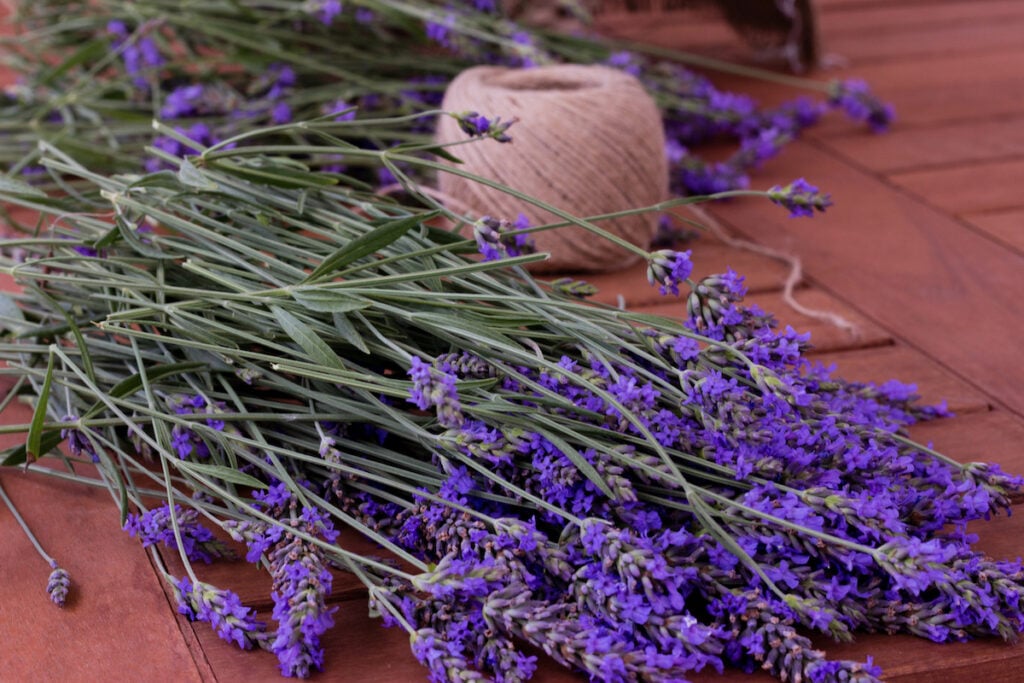There’s a reason lavender can be found so often in landscaping and gardening, from humble flower beds to breathtaking castles and estates: this flower’s uses are endless! From repelling insects like ticks and mosquitos to calming the nervous system and adding beauty to your landscaping, lavender is incredibly useful to have around.
Propagation allows you to keep up an endless supply of your lavender plant without buying new blooms! Read on to learn all about propagating lavender, from best methods to necessary tools to a step by step how-to.

Propagating Lavender From Cuttings: Why It’s the Best Option
While there are a couple of options for propagating lavender, the best and most effective method is to propagate lavender from cuttings. These cuttings—which are trimmed off of your mature lavender plants—can then be planted in soil. Lavender is particularly notorious for rooting effectively in soil.
Which Types of Lavender Cuttings to Use
There are two types of cuttings you can use when propagating lavender. These are hardwood and softwood cuttings. The kind of cuttings you propagate from will depend on when you take the cuttings and will affect the rooting time of your new lavender plants.
Softwood lavender cuttings refers to cuttings which are taken from new growth on your lavender plant, typically during the warmer flowering months, They are the flexible, softer tips of this new growth and will tend to take root in about two weeks to a month.
Hardwood lavender cuttings refers to lavender taken from the plant in the colder months, after the plant has finished flowering. These hardwood cuttings will take just as well, but they will take longer to root—about a month to a month and a half.
When propagating lavender, your best bet is to find stems that are long enough to have a clear transition from old growth to new. This will look like dark brown old growth (hardwood) and light green new growth (softwood).
When propagating lavender in the warmer months, it’s the softwood you want. Reserve the hardwood for propagating lavender in the cooler months.
How to Propagate Lavender From Cuttings: A Step by Step Guide

1. Tools to Propagate Lavender
In order to make propagating lavender a simple and quick task, it’s important to gather your propagation tools ahead of time. To propagate lavender effectively, you will need a mature lavender plant from which to take the cuttings. To remove them, you will need sharp pruning shears or scissors.
For placing your propagated lavender cuttings, you will need a good potting mix and a small plant pot. You may also want to use rooting hormone. If you plan to propagate in water, a wide-mouthed glass container is preferable. With water rooting, you will also need a clear plastic bag or a plastic gardening dome.
2. Choosing the Right Stems to Propagate From
Picking out the right stems to use is a crucial part of propagating lavender effectively. You want stems that are straight and healthy looking, with good color, and without any droopage or sign of insects or disease.
You also want to propagate lavender from stems that are free of any buds or blossoms. These flowering spots will pull away energy that the roots need for propagation, so be sure to avoid taking them when you propagate.
3. How to Properly Remove Cuttings from a Lavender Plant
Using your sharp, clean pruning shears, or a pair of equally sharp garden or household scissors, remove several lavender stems from your mature plant, aiming to take from the softwood if you are propagating lavender in the warmth months.
These stems should each be about three to four inches long.
4. How to Prepare Your Lavender Cuttings for Propagation
To prepare your lavender cuttings for propagating, first remove all of the leaves from the lower two inches of each stem. This is the part you will place into the soil.
At this time, you also have the option to dip the lower two inches of the lavender stems into rooting hormone. Rooting hormone is helpful in encouraging healthy rooting when propagating lavender and other plants, as it adds a nutrient boost to the cuttings.
You can purchase rooting hormone online, or you can make an easy homemade blend yourself. While this is not a necessary step given lavender’s penchant for easy propagation on its own, you may lean more toward using rooting hormone when propagating lavender in the colder months.
5. How to Root Your Lavender in Water
If you are propagating your lavender in water, you will want to fill your glass container with clean, filtered water to such a level that the lower two inches of the lavender stems are covered. Don’t let the leaves submerge, as this can lead to leaf rot.
Cover the glass container with a clear plastic bag or a gardening dome, as this will encourage a humid environment perfect for encouraging root growth. Place the container of lavender cuttings somewhere warm and bright, but away from direct sunlight.
You will need to change the water every few days to avoid bacterial growth around your lavender cuttings. After several weeks, you will begin to see the lavender cuttings forming roots. Once these extend to about one to two inches, it’s time to transplant your lavender cuttings.
Transfer your rooted lavender cuttings into small pots filled with well draining soil. Wet the soil thoroughly, but don’t allow for standing water. Place them in the sunlight and allow them to root to the soil before moving to a larger pot or transplanting outdoors.
6. How to Root Your Lavender in Soil
When rooting your lavender cuttings directly in the soil, prepare your planting pot by filling it up with potting soil to about an inch below the pot’s rim. Use the tip of your finger or the eraser end of a pencil to poke several holes into the potting mix.
Into each of these holes, place the end of a lavender stem from which you have removed the leaves (and possibly dipped in rooting hormone). The bare part of the stem should fit entirely into the hole. Using your fingertips, gently pack the soil in around the stem. Then, be sure to water the soil deeply but without drenching.
Place your potted lavender cuttings somewhere warm and bright, without direct sunlight exposure. Continue to water regularly, keeping the soil moist but not too soggy.
After about two to four weeks (or four to six weeks, if you are using hardwood cuttings), give your lavender cuttings a very gentle tug. If you feel resistance, that’s an indication that your cuttings have taken root!
7. How to Transplant Your Lavender
Once your lavender cuttings have taken root in the soil, you can either transition them into larger indoor pots or transplant them outdoors. They should be thriving in a container of at least five inches in diameter and should be six to eight inches tall before you transplant them outdoors.
If there are flowers on your lavender cuttings, go ahead and remove the buds or blooms and prune down to about four to six inches of growth above the soil (this will encourage the roots to establish in their new soil).
Transplanting Lavender Cuttings Outdoors
Before you plant your lavender cuttings outdoors, make sure the soil is ready. Lavender needs broken-up, loose, well-draining soil that has a neutral or slightly alkaline pH and low fertility and nitrogen levels. You can ensure drainage by adding in sand or some peat moss alternatives.
Once the soil is ready, dig a hole in it that’s two to three times wider and deeper than the root ball of your lavender plant. Then, water your lavender plant thoroughly in its pot, as this will help reduce transplant shock.
Now you can remove your lavender plant from its growing pot. To do this, grasp the plant gently at its base and carefully wiggle it until the root ball releases. If you find any roots that are tightly coiled or have taken on the shape of the pot, use your fingers to gently loosen them up so they can grow out into the new soil.
Place the young lavender plant in the hole so that it’s even with the soil line. Then, gently backfill the hole, ensuring that the plant’s central crown remains above the soil. Water deeply around the plant and mulch to help retain moisture.
Transplanting Lavender Cuttings Indoors
If you are transplanting your lavender cuttings to continue growing indoors in a more permanent container, you will want a container between 12 to 24 inches in diameter. Make sure it’s made of breathable material, such as terra cotta or ceramic, and fill it with the same sort of loose, well-draining soil that you would use when planting outdoors.
Ensure your lavender pot has room in a south-facing window with access to lots of direct sunlight. If this is difficult to achieve in your home, consider investing in additional grow lights to help keep your lavender plants happy.
Whether indoors or outdoors, your lavender cuttings will need regular watering, once weekly, for about the first month. Let the soil dry out between waterings. Then, after your lavender plant is established, you can switch to watering every two to three weeks.
A Frequently Asked Question About Propagating Lavender

Are there other ways to propagate lavender?
In addition to propagating lavender from cuttings, lavender can also be propagated by seed. However, this is a much more delicate and time-consuming process and can have a lower success rate than propagating lavender from cuttings.
Wrapping Up Propagating Lavender
Excited to start propagating lavender from your mature plants? Check out our ideas for how you can use your newly propagated lavender to enhance your unique backyard space!
- About the Author
- Latest Posts
Renee Dugan is a lifelong writer, professional editor, and lover of all things nature, gardening and the big outdoors.
A Midwest girl who’s been in the garden since she could first hold a hand trowel, Renee’s love of growing things has bloomed into a passion for healthy living, holistic lifestyle, and knowing where our food comes from.
Now a mother and maturing gardener herself, Renee is passionate about channeling everything she knows and continues to learn about gardening into lessons for her son and others. Her excitement for sharing this knowledge is only superseded by her excitement about being able to finally grow her own citrus plants in pots.
Renee can be reached at renee.s.dugan@gmail.com

